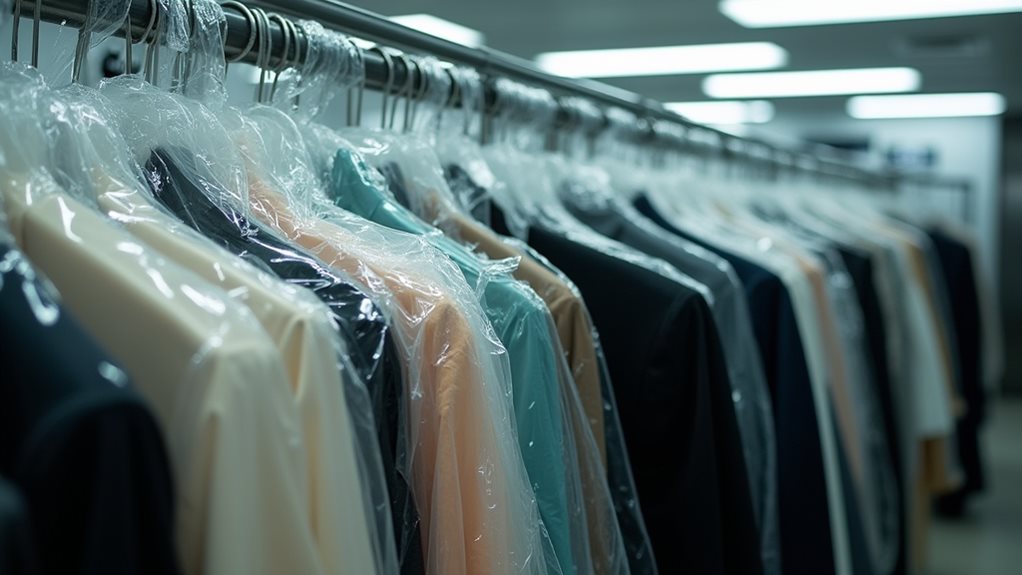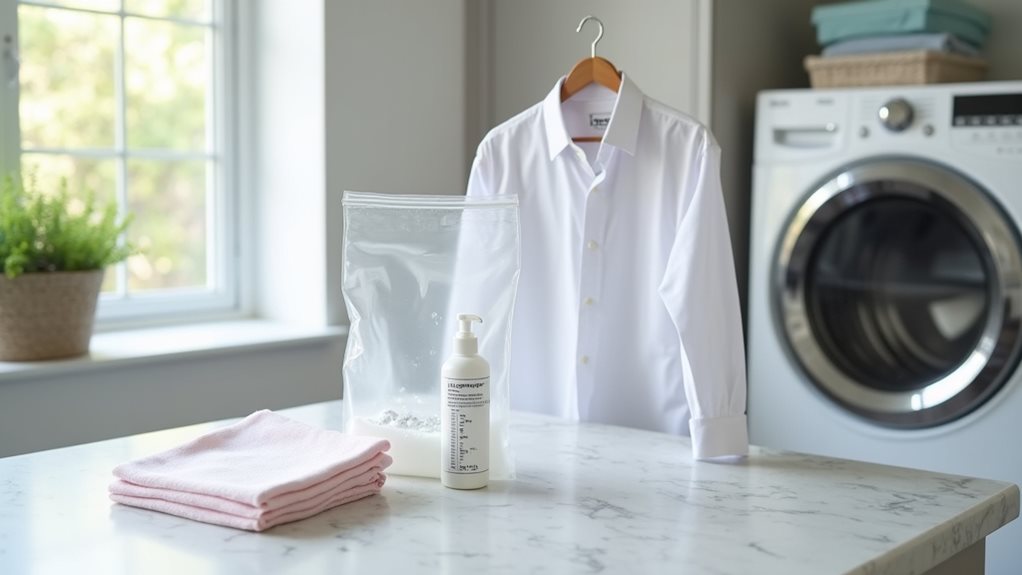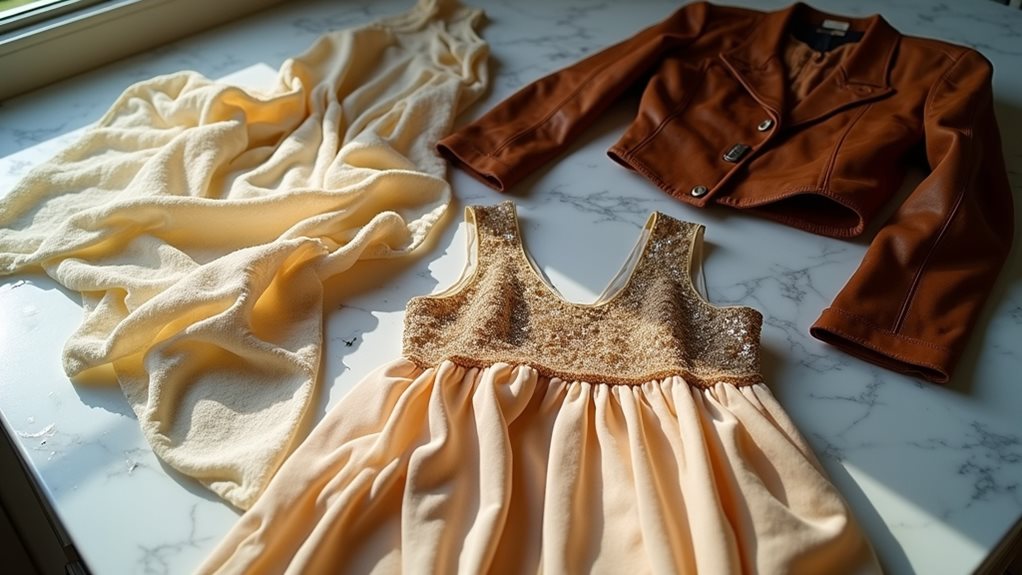Most dry cleaning takes 2-3 days for standard items like dress shirts and trousers, though I’ve learned the hard way that delicate garments need 3-4 days, while formal suits require 3-5 days for proper pressing. You’ll face longer waits during holiday rushes or when dropping off heavily soiled clothes – I once waited a week during prom season! Home kits work in 30 minutes but aren’t suitable for deep cleaning, and timing your drop-off during non-peak hours can speed things up considerably.
Understanding the Dry Cleaning Process and Turnaround Factors
When I first started dropping off my work clothes at the dry cleaner down the street, I honestly thought it was some kind of magical process where my wrinkled blazers disappeared into a mysterious back room and emerged perfectly pressed the next day 😅.
I used to think dry cleaning was pure magic – wrinkled clothes vanishing into a mysterious back room, emerging perfectly pressed overnight 😅
Turns out, the dry cleaning process involves five distinct steps that directly impact your turnaround time: drop-off, inspection, cleaning, pressing, and quality control.
Your local dry cleaners can handle standard clothing in one to two days, but delicate garments require special attention that extends cleaning times to three or four days.
Factors affecting scheduling include holidays, special events, and garment condition, while intricate items like wedding dresses need anywhere from three days to several weeks for proper care.
Most dry cleaning services require 2-3 business days for regular items, though same-day service is often available for an additional fee.
Timeframes for Different Types of Garments

Although I used to assume all garments took the same amount of time to clean, I quickly learned that your favorite silk blouse and your everyday cotton shirt live in completely different timelines at the dry cleaner.
Standard clothing items like dress shirts and trousers typically require just 1-2 days for processing time, making them perfect for those last-minute wardrobe emergencies we’ve all experienced 😅.
However, time can vary greatly based on complexity – delicate garments with intricate fabrics need 3-4 days of careful attention, while formal suits require approximately 3-5 days for thorough cleaning and pressing.
Larger items like comforters can stretch cleaning turnaround to a full week, and your precious wedding dress may need anywhere from 3 days to several weeks depending on cleaning for certain preservation requirements.
Garments with stubborn stains or damage may require specialized treatment that extends the normal cleaning timeline beyond standard processing times.
Understanding these timeframes helps manage expectations and prevents dry cleaning taking longer than anticipated disappointments.
Factors That Can Extend Your Wait Time

While predicting your dry cleaning timeline might seem straightforward based on garment type, several sneaky factors can turn your expected two-day turnaround into a week-long wait that leaves you scrambling through your closet for backup options.
Holiday rushes create chaos as the volume of customers overwhelms dry cleaners, causing processing times to stretch painfully long.
Holiday madness hits dry cleaners hard—expect your usual quick turnaround to become a frustratingly long wait as customer volume explodes.
Those extremely soiled clothes you’ve been avoiding? They’ll need meticulous cleaning that extends your wait times considerably.
Big local events trigger delays when everyone suddenly needs formal wear cleaned simultaneously, and staff limitations during peak periods slow everything down.
Even dropping off items during evening rush hour affects turnaround times, since that’s when most working folks think to handle errands—classic timing! 😅
Delicate items like wedding dresses or leather goods may require specialized cleaning processes that extend the timeline to 5-7 days or longer due to their complex care requirements.
Home Dry Cleaning Kit Processing Times

Why wait for professional cleaning when you can tackle those “dry clean only” garments at home in a fraction of the time?
Home dry cleaning kits offer remarkable convenience, transforming your typical processing times from days to just 30 minutes to an hour.
I’ve found that pre-treatment of visible stains adds maybe five minutes upfront, but it’s worth every second for stubborn spots.
The tumble drying phase activates the cleaning solution and runs about 30 minutes, giving you time to catch up on emails or fold laundry.
While these kits won’t match professional cleaning for heavily soiled items, they’re perfect for revitalizing clean garments between professional visits, saving you both time and money! 😊
Always test the cleaning method on an inconspicuous area first to ensure your fabric won’t be damaged during the home cleaning process.
Items That Cannot Be Dry Cleaned

Before you rush to the dry cleaner with every stained garment in your closet, you’ll want to pause and consider that some items simply can’t handle the chemical process, no matter how desperately you wish they could.
I learned this the hard way when I confidently dropped off my grandmother’s vintage beaded dress, only to pick up what looked like a sad, deflated version of its former glory 😅.
Your precious fur coats, leather jackets, heavily embellished evening wear, and certain delicate fabrics like silk or suede need specialized care that standard dry cleaning just can’t provide without risking permanent damage.
Additionally, activewear made from synthetic moisture-wicking materials, swimwear, and down-filled items should stick to gentle washing methods since dry cleaning’s harsh chemicals can break down their specialized properties.
Fur and Leather Items
Some of your most treasured wardrobe pieces—that luxurious fur coat from your grandmother or those butter-soft leather boots you splurged on—actually can’t go through traditional dry cleaning.
I learned this the hard way when I watched a dry cleaner’s face turn pale after I dropped off my vintage suede jacket.
Fur garments lose their natural oils during standard cleaning processes, while leather items need specialized cleaning methods that traditional solvents simply can’t provide without causing damage.
Even items with care labels saying “dry clean only” might surprise you—delicate fabrics and heavy embellishments often require alternative approaches.
While most delicate fabrics like silk, wool, and cashmere thrive with professional dry cleaning, fur and leather pieces require completely different specialized care methods.
Here’s what needs special attention:
- Fur coats – require conditioning treatments
- Leather jackets – need moisture-preserving techniques
- Suede accessories – demand gentle, specific cleaning processes
Always check those care labels carefully!
Heavily Embellished Garments
Beyond fur and leather, there’s another category of garments that’ll make your dry cleaner shake their head and politely decline your business—those gorgeous, heavily embellished garments that you probably spent way too much money on because they caught the light just right in the store.
When your dress features intricate beading or sequins, the standard dry cleaning process becomes a nightmare scenario, with agitation and solvents threatening to destroy those delicate details you adored.
Most cleaners will direct you toward specialized care services that use specialized cleaning techniques, because honestly, they don’t want the liability of ruining your statement piece.
Always check the care label for specific cleaning instructions, and remember that extra care means considerably more time needed for proper maintenance.
However, many beaded and sequined items that are professionally constructed can actually be safely dry cleaned using chemical solvents that preserve the garment’s integrity without the damaging effects of water and agitation.
Delicate Fabric Exceptions
While many fabrics thrive under the careful attention of professional cleaning, there’s a surprising number of delicate materials that’ll actually suffer more damage from those solvents than if you’d just tossed them in your washing machine at home.
These three garments should never see the inside of a dry cleaner:
- Fur coats – Those harsh chemicals strip away natural oils needed for preservation.
- Certain leather and suede pieces – They require specialized cleaning methods that standard dry cleaning can’t provide.
- Ultra-delicate fabrics like vintage silk – They’ll shrink faster than your enthusiasm for laundry day 😅
Additionally, garments with embellishments such as sequins or beads can dissolve or become damaged when exposed to dry cleaning chemicals.
Always check care labels before dropping off your garments, because sometimes the gentlest cleaning methods happen right in your own laundry room, not at the professional cleaner’s.
Proper Storage Methods for Dry-Cleaned Clothing

To store dry-cleaned items properly, ditch those plastic covers dry cleaners hold your clothes in—they trap moisture buildup that leads to mildew.
Instead, invest in breathable garment bags that protect from dust while allowing air circulation. Always use padded hangers to maintain their shape, because trust me, shoulder bumps are fashion’s silent killer.
Keep dry-cleaned pieces in cool, dry spaces away from sunlight, and regularly check storage area for moths—those little fabric terrorists don’t discriminate between expensive and bargain finds.
While dry-cleaned garments can get wet without permanent damage, proper storage helps prevent unnecessary moisture exposure that could lead to water spots or other issues.
Tips for Faster Dry Cleaning Service

Everyone wants their dry cleaning back yesterday, especially when you’ve got that important meeting or special event looming.
I’ve learned through years of last-minute wardrobe emergencies that timing your drop-off can make all the difference between getting your clothes back quickly or waiting in processing purgatory.
Here’s how to help your dry cleaner determine the fastest cleaning time:
- Drop off garments during non-peak hours – early morning or mid-afternoon to avoid longer wait times
- Pre-treating stains at home reduces processing time considerably
- Communicate special requests upfront so cleaners can prioritize accordingly
Ask about expedited cleaning services for urgent needs, though expect additional fees.
Most cleaners hold clothes ready within 24-48 hours during normal periods, but it’s reasonable to expect timely service when you’ve done your homework on timing.
For the most urgent situations, some specialty cleaners offer 1-hour emergency service that can handle critical wardrobe needs when you absolutely cannot wait for standard processing times.




